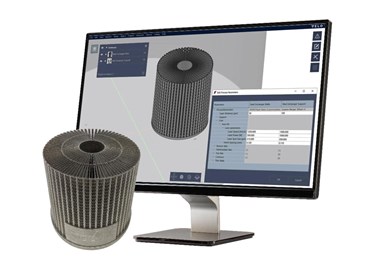Velo3D’s Flow Developer Enhancement Simplifies Parameter Development Process
The Developer enhancement in Velo3D’s Flow print preparation software gives users the freedom to migrate their own 3D printing parameters, even if developed on other brand machines, to a Velo3D Sapphire system where they can take advantage of machine-to-machine repeatability for series production.
Developer's process parameter editing screen showing different parameter sets for walls and supports that feature customized layer thickness, laser power, laser scan speed and laser spot size. Source: Velo3D
Velo3D’s Flow Developer print preparation software unlocks full transparency and control of the parameters used in the 3D printing process. With the flexibility of Flow Developer, users can transfer their experience and knowledge from previous projects, develop new material processes and control their optimization objectives. This software enhancement greatly simplifies the migration of additive manufacturing (AM) projects to Velo3D’s fully integrated solution.
Developer is available for users of Flow 7.0, the latest version of Velo3D’s print preparation software that seamlessly turns traditional design files into print files. Developer grants editor-level access to print parameters, giving companies maximum flexibility and control when working with their Velo3D AM solution. With this access, users can import proven parameters they have developed, optimize default parameters for specific application needs, and develop parameter sets supporting new material development for novel solutions and specific applications. Once a part that was produced using Developer has been qualified, users can scale production leveraging the control, quality and repeatability of Velo3D’s AM solution.
“It can be a challenge to produce repeatable results across different metal 3D printers — even when they’re the same model of printer. However, Velo3D’s solution can consistently produce parts within spec across any of its printers, which provides huge benefits for companies looking to scale production of their parts,” says Thomas Pomorski, additive manufacturing manager at Ursa Major. “When our team first tested Flow Developer, we transferred parameters we developed on a non-Velo system, hoping we could easily produce the same part on Velo3D’s system and then take advantage of the scalability it provides. On our first try, we imported a part with highly complex, sensitive features and achieved incredible results that were within specification. Since then, we’ve accomplished the same process with other parts and, in some cases, have been able to reduce print time by nearly 50% without sacrificing accuracy or quality.”
Prior to its general release, Developer was made available to select customers for feedback, including Ursa Major, a privately funded company developing rocket propulsion technology. During this phase, engineers were able to directly transfer their custom parameters into their Velo3D solutions with exceptional results, the company says. Developer gave early-access customers the ability to easily scale production of their parts as their applications matured from development to production.
“Velo3D’s mission has always been to provide an additive manufacturing solution that delivers repeatability from machine-to-machine, which is still a big shortcoming with legacy metal 3D printers,” says Brad Kreger, Velo3D CEO. “Previously, we did this by providing predefined parameters within the system, which left customers wanting to know what’s inside our ‘black box’ and looking for more flexibility. When you combine Flow Developer with our ability to produce identical parts using the same print file, we strike the perfect balance between usability, repeatability and flexibility. This has allowed these early access customers to think outside the box of conventional additive manufacturing to progress beyond their current limitations and realize true production scalability for their parts.”
Flow is a key part of Velo3D’s unique approach to AM, which differs from competitors’ offerings by providing a fully integrated solution that includes hardware and software, which come together to ensure machine-to-machine consistency. In addition to Flow and the Sapphire family of printers, the company’s solution also includes Assure quality assurance software, which monitors a print layer-by-layer to ensure consistent geometric accuracy, surface finish and material properties throughout a finished part.
Related Content
3D Printed Cutting Tool for Large Transmission Part: The Cool Parts Show Bonus
A boring tool that was once 30 kg challenged the performance of the machining center using it. The replacement tool is 11.5 kg, and more efficient as well, thanks to generative design.
Read MoreUser-Friendly Mass Spectrometry Tool to Enable AM
The Massbox is a technology designed to simplify mass spectrometry by bypassing the need to send samples to the lab for characterization and testing purposes. Exum Instruments’ debut tool is suitable for AM as it can assist with quality assurance, material characterization and failure analysis.
Read MoreImplicit Modeling for Additive Manufacturing
Some software tools now use this modeling strategy as opposed to explicit methods of representing geometry. Here’s how it works, and why it matters for additive manufacturing.
Read MoreCopper, New Metal Printing Processes, Upgrades Based on Software and More from Formnext 2023: AM Radio #46
Formnext 2023 showed that additive manufacturing may be maturing, but it is certainly not stagnant. In this episode, we dive into observations around technology enhancements, new processes and materials, robots, sustainability and more trends from the show.
Read MoreRead Next
Bike Manufacturer Uses Additive Manufacturing to Create Lighter, More Complex, Customized Parts
Titanium bike frame manufacturer Hanglun Technology mixes precision casting with 3D printing to create bikes that offer increased speed and reduced turbulence during long-distance rides, offering a smoother, faster and more efficient cycling experience.
Read MoreAlquist 3D Looks Toward a Carbon-Sequestering Future with 3D Printed Infrastructure
The Colorado startup aims to reduce the carbon footprint of new buildings, homes and city infrastructure with robotic 3D printing and a specialized geopolymer material.
Read More3D Printed Polymer EOAT Increases Safety of Cobots
Contract manufacturer Anubis 3D applies polymer 3D printing processes to manufacture cobot tooling that is lightweight, smooth and safer for human interaction.
Read More






















